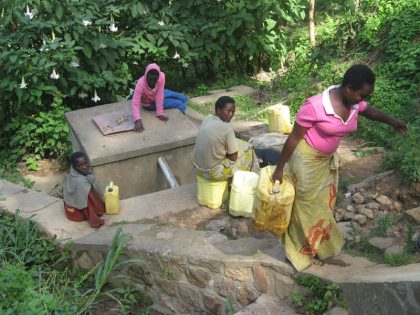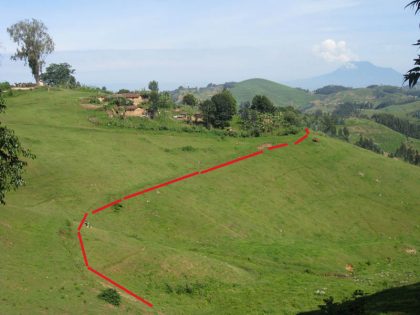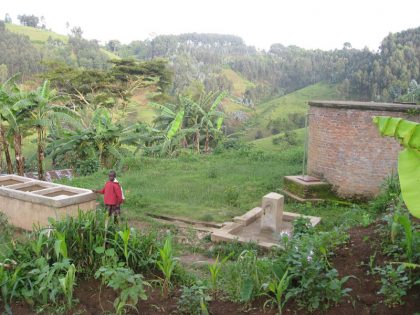 Location
Location
Kinihira village, Rutsiro district, Rwanda
Community Description
Kinihira is a rural village of 118 households in Western Rwanda, bordering Gishwati forest. The village was settled after the 1994 genocide, largely by returning refugees. It is located 1-2 hours from the main road to Gisenyi and has limited access to goods, as the nearest market town is an hour’s walk.
The village stretches down a steep hill. The primary occupation of villagers is farming and cattle raising, and the village is well known for its milk production.
The system that provides water to the village has been in place since 1996, with little maintenance apart from repairing broken taps.
 Kinihira Health Center serves 19 villages and 13,138 people and is located 10 minutes away down a steep and rocky hill. Kinihira is also home to a primary school serving 660 children. In January the school will expand to cover the first 3 years of secondary school (the “9 year basic” free education).
Kinihira Health Center serves 19 villages and 13,138 people and is located 10 minutes away down a steep and rocky hill. Kinihira is also home to a primary school serving 660 children. In January the school will expand to cover the first 3 years of secondary school (the “9 year basic” free education).
The school and health center have rainwater collection systems that are sufficient during the rainy seasons. In the dry season, the taps often run dry and villagers sometimes must fetch river water, which is at a greater distance and of poorer quality.
Members of the village fetch water in jerrycans from either a tap at the very bottom of the village or the health center. Both taps require a long walk up a steep hill to return home, and it is common to see young children with 2- and 5-liter jerrycans fetching water after school as well as women carrying heavy 20-liter jerrycans.
The source of water for the village is located 1.5 kilometers away. It is a natural spring inside a hill that provides water even during the dry season. Near the source, there is a 300-liter square tank made of bricks and cement.
 A second tank, which holds 15,000 liters is located in the village. It is made of metal-reinforced cement, surrounded by cement and bricks. Water leaving the source tank flows to the village tank through a plastic pipe that winds along the contours of the valley.
A second tank, which holds 15,000 liters is located in the village. It is made of metal-reinforced cement, surrounded by cement and bricks. Water leaving the source tank flows to the village tank through a plastic pipe that winds along the contours of the valley.
Most of the pipe is well-buried and in good condition. However, its path is bound by the contours of the land and gravity, as there is no pump or generator to propel the water to the village tank.
In 8 places the pipe has become exposed or damaged, largely due to cattle grazing, farming, and other human activities.
A third tank is located at the health center. It is filled by a combination of rainwater collection and water from this pipeline. As the pipeline approaches the village, there is a division, intended to provide water to both the village and the health center. However, this was done improperly, causing all of the water to go to the health center tank, and none of it to the village, until the health center tank is full. When the village tank is dry villagers must go to the health center, a steep and rocky return walk of over 600 m.
The tank in the village has 3 pipes that are supposed to bring water to 3 taps in the village. Each tap has a faucet as well as a cement area designed for women to do their laundry at the tap.
Only one lower tap is functioning. This means that many villagers must hike back up the hill with their water.
Project Description
This project remediates all of the water supply problems endured by the village. The project has 3 parts: First, the pipes between the tanks will be repaired. Second, a problem that improperly divides the water supply between the village tank and the health center tank will be remediated. Third, faucets and valves will be replaced so that water is restored to all of the taps in the village.
Pipeline Repair
Project funds will pay for the repair of the pipeline at the 8 problem locations, including materials and some labor. The remainder of the labor will be provided by village volunteers.
An information campaign and plan to demark the path of the pipe will prevent future damage by human activity. There is also a local committee that meets to assess potential problems with the water and identify pre-emptive solutions.
Correction of Water Distribution Problem
Project funds will pay for an engineer to arrange for the proper distribution of the water between the health center and village. The job will be accomplished by digging to expose the problem and then reconfiguring and reburying the pipes.
Tap Repairs
Project funds will pay for 5 faucets (two of the tap locations have 2 faucets) which are 15 years old and not functioning.
Also, where the 3 pipes leave the village tank to bring water to the 3 taps, there are several valves, two of which are broken. Project funds will provide for high-quality, long-lasting replacements for these valves.
Project Impact
This project will benefit approximately 800 people living in 118 households in Kinihira village. It will also benefit the 13,138 people served by the health center.
Peace Corps Volunteer Directing Project
Trude Raizen
Comments
This is a system-wide effort to ensure a secure water supply for the village and the health center, especially in the dry season. It will have a tremendous impact upon the lives of a large number of people who presently must spend hours each day collecting water, a burden that falls on the shoulders of women and children.
Dollar Amount of Project
$500.00
Donations Collected to Date
$500.00
Dollar Amount Needed
$0.00 – This project has now been fully funded through the generosity of Ng Yit Chong, of Singapore.
We encourage others to continue to donate using the Donate button below, and we will notify Trude of your donation. Additional funds will be used to fund the next project by Trude and/or those of other PCVs in Rwanda.
This project has been finished. To read about the conclusion of the project, CLICK HERE.